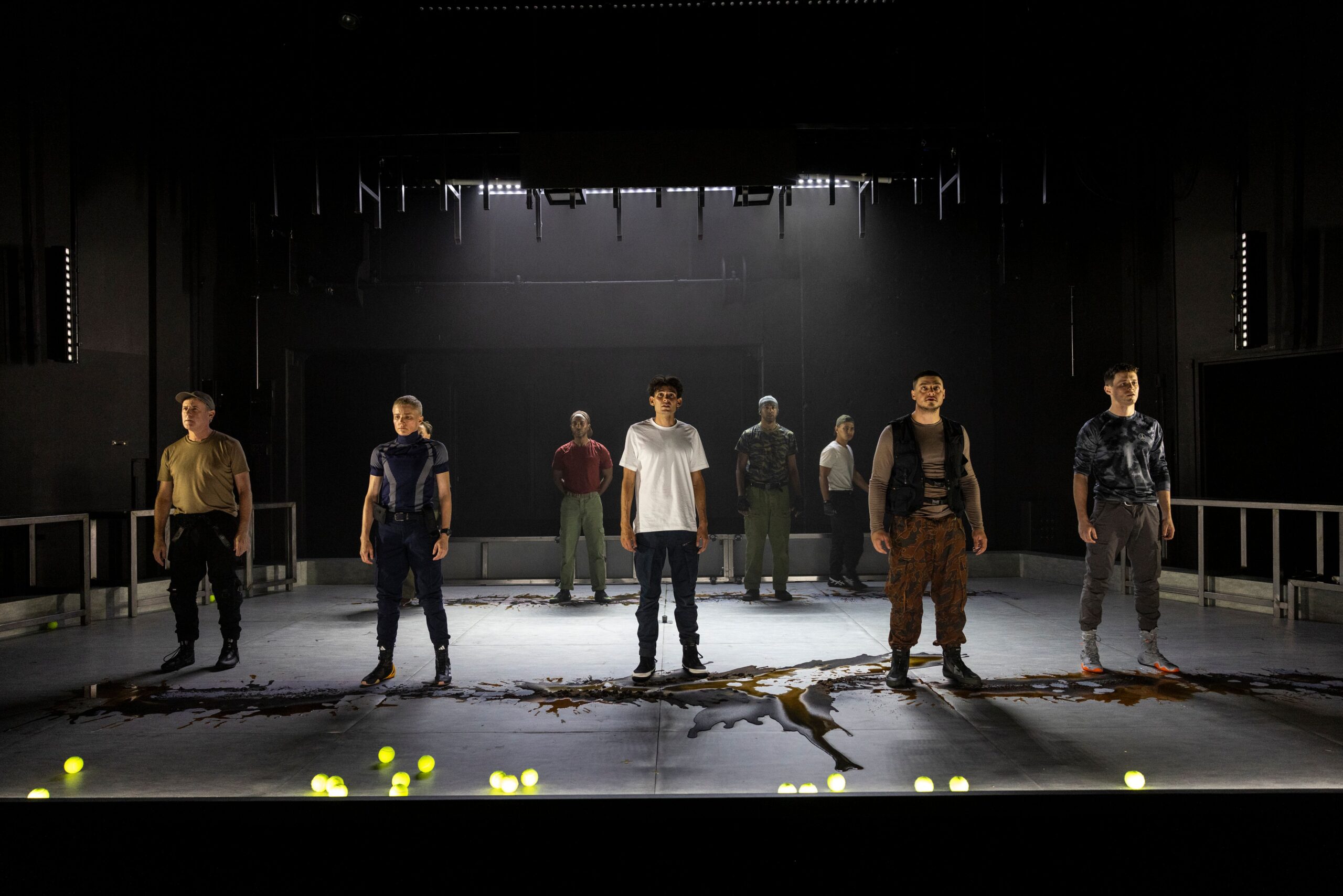How far would you go for ego?
Marion Potts’s modern interpretation of Shakespeare’s Henry 5 asks this question. After a degrading prank by the French court, the new adolescent king of England sets out to defend his pride through war. Henry 5 explores his unlikely journey to victory at Agincourt, and its devastating effects. Focusing on the physicality of war and its impact on humanity, Henry 5 forces us to confront the realities of conflict, leadership, and those who witness history in the making.
Many of Potts’s staging choices make the events of Henry 5 seem like they’re being retold for our benefit. The prologue and a number of other speeches are performed from front and centre, with characters sitting on a steel chair and addressing us directly through a microphone. On a screen above the stage, names are displayed with ID numbers, as though the characters are testifying in court, whilst the historian at the side of the stage acts as a record-keeper, typing away as they speak. We are asked, directly, to join the fray ourselves – telling us it is our duty to picture the story as though it is happening before our very eyes. There is no space for the audience to disconnect themselves from the story or passively watch on. We are implicated as witnesses and participants in something we’d rather be looking away from.
Designer Anna Tregloan brings the play into a significantly contemporary setting with her set, opening on a training camp re-imagined as a gym, and the subdued, casually modern clothing. The familiar environment and costuming, along with the actors’ relaxed, hypermasculine interactions in the opening scenes makes them seem like real people to us. They aren’t cartoon soldiers or 1400s nobility – they’re our classmates, brothers, co-workers, neighbours. This furthers the play’s confrontation of the audience: this could be you, or anyone you know.
All the costumes relay this sense of familiarity, except for one: Katherine. The French King’s daughter is dressed in a blinding yellow dress whilst attempting to learn English in preparation for her inevitable marriage for peace between the countries. The jarring nature of her presence on stage is a reminder of her externality to the world of kings’ squabbles until she’s forcibly used as a pawn in their game. Simultaneously, the visual contrast furthers her alienation on stage, focusing on the importance of her unique experience with arranged marriage and assault.
The use of mud on stage to resemble the carnage of war created a shockingly visceral image. As the actors ran and slipped, they became coated in the dirt, looking almost unrecognisable by the end of the battle. For those who survive, clean costumes are provided, including a bucket of water for Henry to wash himself onstage. For those who don’t, the filth remains on them for the rest of the play as they stand silent witness to the aftermath. The English flag was carved into the mess following the completion of the battle, prompting us to question the meaning of their victory: what has been gained? Is this disgusting scene glory?
Sound designer and composer Jethro Woodward’s choice to have actors on stage making all of the human sound effects – such as breathing, marching, and singing – reiterates the human element of war that Potts conveys. In Westmoreland’s death scene in particular, as he squirms in the mud, actor Ava Madon (not playing any character in particular at the time) makes a heartbeat sound effect with her voice. It asks the question of who Westmoreland’s death will affect, drawing our attention to the moment his heart stops. The ambient, buzzing underscore creates a tense atmosphere, punctuated by sudden, startling bursts of sound that keep the audience on edge.
One of Henry 5’s greatest triumphs is the first fight scene. Potts’ decision not to use any weapons for the battles in order to emphasise the bodily aspects of violence forces the actors to fight in close proximity. With extreme physical elements such as jumping over set pieces, the fight feels raw, dangerous, and connected. The fight freezes every few beats, with Madon’s panicked breathing and whimpering reminding us of how terrifying it is to have your life put on the line. Drawing us into their breathing pattern causes the whole audience to embody the fear that characterises war, once again forcing us to consider ourselves as part of the story. JK Kazzi’s rendition of the famous ‘Once more unto the breach’ monologue is absolutely spine-chilling. His use of breath throughout his powerful scenes authentically reflected his character’s passion, anger, and determination within the war, convincingly portraying the complexities of King Henry.
Marion Potts’s adaptation calls for its modern audiences’ to reflect on the perpetually timely themes of the old tale. Our desensitisation to the devastating news fed to us by our phone screens is shattered once we sit in the theatre and watch it play out in a tangible, embodied, up-close-and-personal context. We’re forced to confront the names of those who have died, in a move reminiscent of sharing victims’ names as an act of remembrance and protest against acts of genocide or racial and gendered violence. The uncomfortable questions raised by Henry 5 about which parts of history are recorded and which are ignored, if leaders have a duty of care to their people, and whether civilian lives are a reasonable price to pay for rulers’ disagreements feel incredibly relevant in 2025.
Written by: Asher Wood and Serena Emanuele




